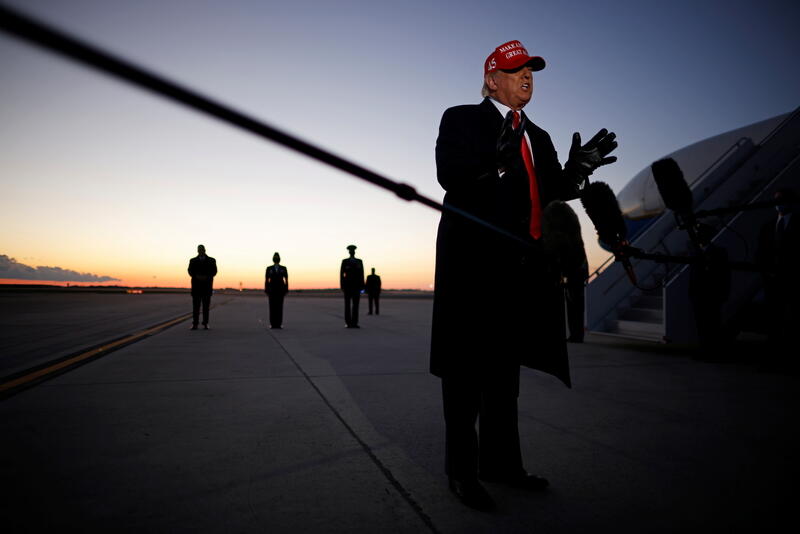We asked people from all over the world how journalists should cover powerful people who lie. Here is what they said

U.S. President Donald Trump speaks to the press after arriving at Charlotte Douglas International Airport in Charlotte, North Carolina, U.S., November 1, 2020. REUTERS/Carlos Barria
This article was first published on 20 February 2017.
Shortly after Kellyanne Conway defended White House Press Secretary Sean Spicer's false statement about attendance at Donald Trump's inauguration as “alternative facts”, we asked a seemingly simple question: how should journalists cover powerful people who lie?
Our starting premise was this—the world is not black and white, neatly divided between truth and untruth, but there are such things as lies, intentionally false statements.
To find truth and report it, and to keep the public informed about public affairs, journalists need to be able to deal with this, especially when powerful people lie in blatant and self-interested ways.
A crowd-sourced response
Inspired by Eli Pariser’s crowdsourced efforts to find effective responses to fake news, we created an open Google Document and invited people from all over the world to share their thoughts and suggestions on how journalists should cover powerful people who lie.
Over two weeks from January 26 to February 9, more than a hundred people from all over the world have contributed with ideas as the document has been shared widely on social media and covered by news organisations in many countries and grown to more than 50 pages.
Read the full document: 'Alternative Facts': how do you cover powerful people who lie?
While the initiative was prompted by the frequency and audacity with which the Trump administration seem to be lying, the challenge is clearly not unique to the United States. And indeed, we have had people responding with examples and lessons learned from many different countries, ranging from Argentina to India, from Russia to Singapore, and from all across Europe.
Those who have contributed come from many different backgrounds (journalists, concerned citizens, academics) and countries (ranging from stable democracies to autocratic states with everything in between), and not everyone agrees on how journalists should cover powerful people who lie. The responses are not representative, they are not exhaustive, and they will not “solve” the problem—but they are interesting and worth sharing.
Below, we highlight what we see as the most important areas of agreement (the do’s and don’ts that most contributors agree on) as well as the most important area of disagreement—whether journalists should try to be impartial or whether they should take a stronger stance.
Do’s – what journalists should do
- Call lies lies and falsehoods falsehoods. Not doing so undermines credibility and trustworthiness with the public (even if it may infuriate partisans).
- In turn, cover the partisans who support powerful people who lie. Understand their world view, give voice to their perspective.
- Get outside the bubble, away from official sources and insider group-think.
- Focus on the substance, not the form, so follow the money and cover consequential and binding decisions made rather than provocations and conspicuous displays of 'doing something'.
- Collaborate. Follow up on each other’s questions. Share notes on sources’ credibility.
Don’ts – what journalists shouldn’t do
- Don’t lead with the false statement in the headline or the standfirst, and don’t succumb to false equivalence ('Views on shape of the Earth differ.')
- Don’t let yourself be distracted by endless tweets and provocative asides—cover the story, not the person. Focusing on every provocation and false statement ends up rewarding the lies with publicity.
- Avoid going live unless absolutely necessary. Consider not broadcasting live press conferences and interviews with sources who are known to be unreliable. Breaking news coverage makes real-time fact-checking hard and publicises the lie.
- Don’t give publicity to unreliable sources. It may produce engaging and provocative content, and in turn bring in an audience and advertising, but long-term, it undermines credibility.
- Don't treat politicians you like or agree with differently than those you dislike/disagree with. Please don’t be one of those journalists who end up sharing false information on social media about politicians they personally do not support.
Disagreement – is impartiality over?
The do’s and don’ts above are areas where many of our contributors agreed. But there were also important areas of disagreement. A central one is around the question of whether journalism should strive to be as impartial and objective as possible or not.
Here, there have been different views.
Some of our contributors argue, as Reuters’ Editor-in-Chief Steve Adler has done, that journalists already know how to deal with powerful people who lie—by offering intrepid and unbiased reporting: “We already know what to do because we do it every day, and we do it all over the world.” Basically, the answer to the problems facing journalism is more journalism.
Others, like the now former NPR Marketplace reporter Lewis Wallace, argue that “objectivity is dead” and that journalists “need to admit that those who oppose free speech, diversity and kindergarten level fairness are our enemies.” The answer here is a more engaged journalism that advocates for some views and against others.
Will it help?
Many journalists aspire to find truth and report it, and by doing that informing the public about public affairs.
That is not an easy task, especially when dealing with powerful people who lie, often in a context characterised by political polarisation, low levels of trust in the media, and dwindling resources in most newsrooms.
Many of our contributors highlighted that news media as we know them are part of the problem. They are seen as complicit with powerful people who lie when many media reward provocative behaviour with publicity (perhaps in part for commercial reasons), offer little critical scrutiny (because enterprising reporting is difficult, expensive, and time-consuming), and as prevaricating when they do not call false statements false. At the same time they are seen as out of touch and hostile by many who may have more sympathy with the liar than with the media.
Journalists who in this situation try to combat lies through a relatively impartial “just the facts, ma’am” approach face the challenge of “backfire effects”, where people whose convictions are challenged by contradictory evidence hold on to their beliefs even more strongly. Those, on the other hand, who take a more confrontational approach risk playing into the hands of those—sometimes the very powerful people who lie—who claim that “the media is the opposition”.
Whether individual journalists and news organisations embrace the impartial or the advocacy view, the do's and don’ts above offer some useful guidelines for thinking about how to cover powerful people who lie—and, crucially, all focus on how journalists can make sure that they put their responsibility to the public and to truth before anything else.
We are grateful to all our many contributors to the full document, to those who sent us comments and suggestions by email and via social media, and to those who shared our questions and call for contribution. We also want to thank the team at @Media_ReDesign for their guidance and help.




